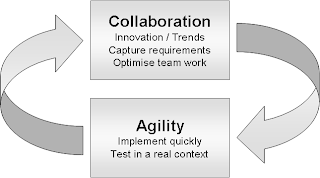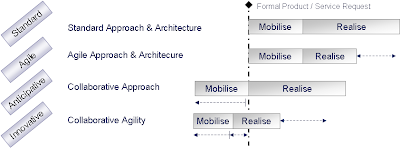I strongly believe that Collaboration can not be dissociated from Agility and that it’s only because we manage these two approaches together that we will meet our objectives.
 We can split a normal project lifecycle in two basic phases, the mobilise Phase and the realise Phase (the operational phase has been removed out of the equation for the simplicity of this exercise):
We can split a normal project lifecycle in two basic phases, the mobilise Phase and the realise Phase (the operational phase has been removed out of the equation for the simplicity of this exercise):- The mobilise phase consists in understanding the requirements for a new product or service, defining a business case, convincing stakeholders and shareholders that this project should be funded, finding the right team and right way to realise the product/service
- The realise phase consists in all the steps of a project development once a budget has been approved and a team is ready to start working on the project.
The aim of Agility as conceived in most cases is to reduce the time necesary for the realise phase. We will then call that approach "Agile". Because customers and employees can interact through Collaboration tools, companies have the chance to have an understanding of what the market wants even before it is formalised as such. This is the kind of initiative targeted by french banks on their Bank 2.0 websites (votrepointdevue.fr (HSBC France), Sijetaisbanquier.fr (marketing campain for Credit Mutuel now closed), ...). In that case the objective is to shift the mobilise phase prior to any formal request. We will call that approach "Anticipative". Finally when combining the two, Collaboration and Agility, companies have the ability to understand the needs from the market prior to formal request and realise it quickly. This gives the chance for the company to be the first to deliver this new product or service that is expected by the market. We will call that approach "Innovative".
The schema here under summarises these 3 approaches and compare them to the standard approach.

An attempt to manage Collaboration without Agility would bring frustrations to the team (including customers); "Why should we collaborate if none of our thoughts can be implemented in a timely manner?"
Collaborative Agility is about being agile as a community (including employes, partners and customers) for the design or revision of products and services.
Definitely, Collaboration and Agility need to be considered together…

No comments:
Post a Comment